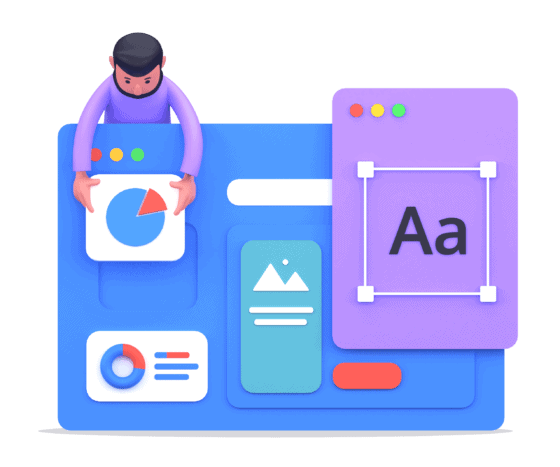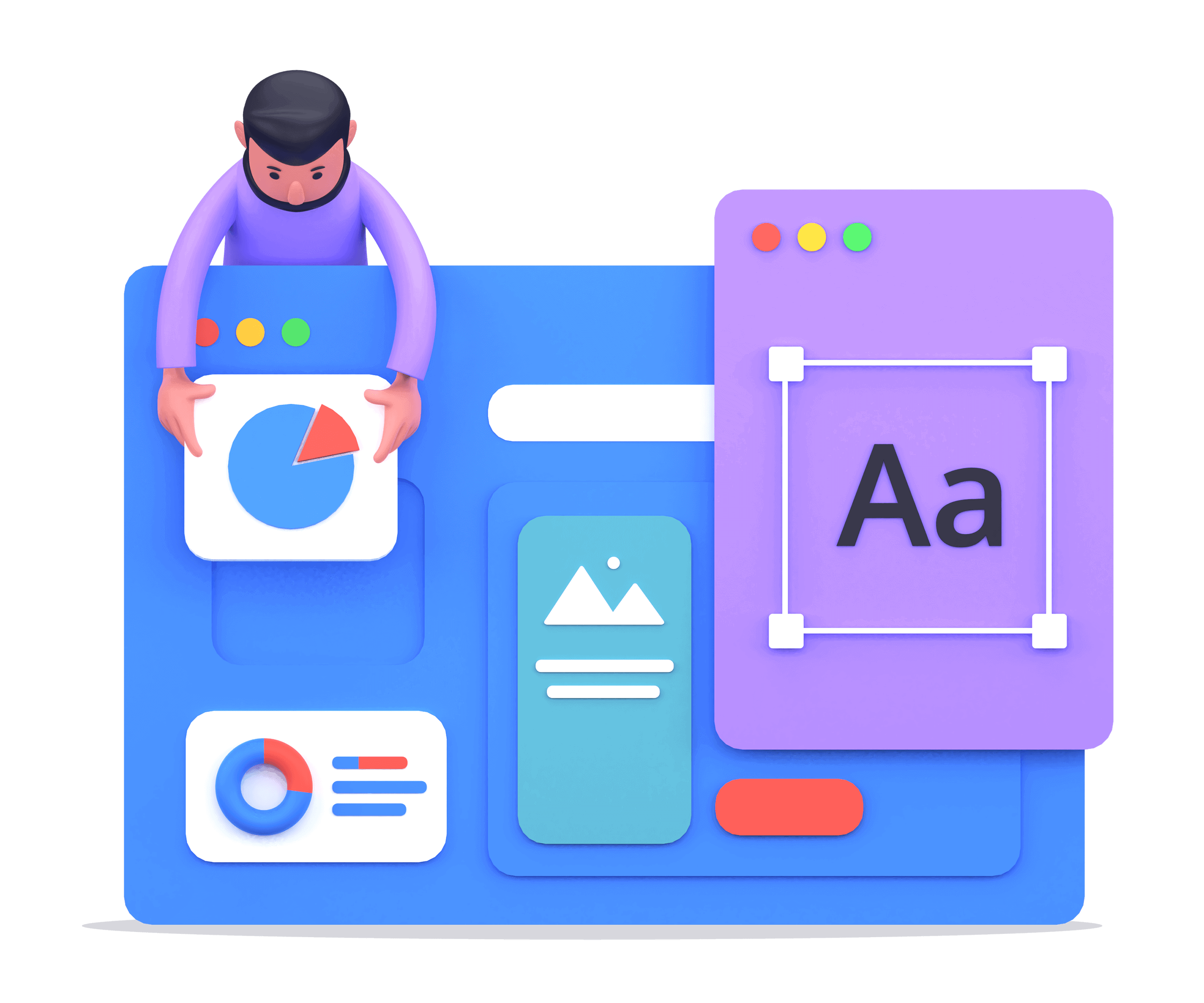
Ah, the digital world of ever-evolving best practices. Your head is probably spinning, trying to keep up with the best approach for your business website. However, keeping an eye on design evolution is essential if you want your website to be a contender in the crowded webiverse.
As businesses and individuals establish their online presence, the most crucial factor in a website’s design lies in its ability to cater to the needs and preferences of its users. This involves striking a unique balance between aesthetic appeal, easy navigation, and the optimal presentation of relevant content to ensure a seamless and engaging experience for website visitors.
So, what does a well-designed website look like? A well-designed website considers numerous factors, all contributing to its overall success. To combine all these elements, you need to understand the website’s purpose, which can vary from an informative platform to enhancing brand credibility and making online transactions possible.
When you have that central focal point, all your design elements can communicate the same message in the same tone and reassure your visitors that your offer is authentic, trustworthy and easy to access.
By creating a brand-reflective design and focusing on content creation, designers can maximise user engagement and ensure their website stands out.
The design process should consider Performance and functional factors to provide an interactive and user-friendly experience. This can include optimising for SEO, designing for different devices, and creating strategic win-win pathways for conversions.
Key Takeaways
- To enhance user engagement and satisfaction, prioritise simplicity and intuition in your navigation while keeping your website user-friendly.
- Ensure your website is mobile-friendly and adjusts seamlessly across various devices and screen sizes to be accessible to a diverse audience.
- Using consistent, visually appealing designs that align with your brand identity helps create a memorable impression that enhances brand recognition.
- Make sure your website is fast. Slow websites can deter visitors and negatively impact user experience and SEO rankings.
- High-quality, relevant content can boost SEO, engage users, and convey your message effectively.
Table of Contents
Understanding the Purpose of Website Design
Website design is crucial in creating an effective and engaging online presence for your business.
The core goal of web design involves aesthetics, usability, and functionality, which work together to cater to user needs for a better user experience. A well-designed website appears visually appealing and ensures smooth navigation and ease of use for its target audience.
For most businesses, an essential objective of website design is driving conversions and helping companies achieve online success through financial gains. To do this, your business needs to be trustworthy. High-quality web design can positively impact a brand’s ability to establish and strengthen relationships with potential customers. This involves focusing on creating websites that are responsive, user-friendly, and aligned with the company’s goals.
Defining clear goals when creating a website is essential. It allows designers to craft an online presence tailored to meet specific objectives and enhance user experience effectively. A solid web design keeps the target audience in mind, reflecting the brand’s vision and values to promote loyalty and brand recognition and increase conversions.
An attractive yet functional website design is paramount in today’s digital landscape. By focusing on engaging aesthetics, user-centric features, and practical usability, businesses can establish a lasting online presence and achieve the ultimate goal of driving conversions.
Creating a Brand-Reflective Design
Regarding brand strengthening, the most essential factor for your website design is ensuring that the design reflects your brand and maintains a consistent visual appearance and tone.
To create a brand-reflective design, focus on these critical elements:
Logo and branding elements
Your brand logo and visual elements must be used wisely throughout the website to reinforce your brand identity. This includes using consistent typography, colour schemes, and graphics.
Clear communication and voice
Your website needs personality to make it legitimate. Otherwise, it just feels like a machine. It will require a deliberate boost to highlight your brand’s unique voice and personality and give some warmth and humanness.
Look to communicate your brand values and mission effectively and engage your target audience to build trust.
You can strengthen communication and voice through:
Website layout and navigation
A well-structured layout does everything. It facilitates easy navigation, ensures a smooth user experience, and reinforces your brand image. Consistency in placing key branding elements, such as the logo and navigation menu, will help your visitors quickly identify your brand.
Content and imagery
Relevant, high-quality content and visuals are vital for representing your brand professionally and creating trust. Steer away from stock images unless they’re within a blog, and include pictures and videos that align with your brand’s message and values to strengthen brand perception.
Consistent user experience across platforms
Ensuring your website has a consistent user experience on different devices and browsers is essential for maintaining your brand’s image. This includes having a responsive design that adapts to varying screen sizes and ensuring compatibility with various internet browsers.

Navigation and Usability
A crucial factor in the design of a website is its navigation and usability. Focusing on user experience (UX) ensures visitors can easily navigate the site, access the required information, and interact satisfactorily. Intuitive navigation and well-designed menus play a pivotal role in achieving this goal.
The foundation of a user-friendly website relies on clear and descriptive navigation labels, allowing users to explore the site seamlessly. Don’t be tempted to use something new to be different or clever. The old menu wordings work for a reason: familiarity, so use it to your advantage.
You can do it yourself: Implement a simple HTML or JavaScript menu to provide consistency across different browsers and platforms. Keep your menus clutter-free and limit the number of menu items for easy access.
Accessibility is another vital aspect to consider in website design for a website’s overall usability and effectiveness. A site should cater to users of various abilities and devices to make it more accessible to a broader audience.
Focusing on Content Creation
Even after your website is completed and published, you still have ongoing work focusing on content creation. A well-thought-out content strategy is crucial in building a successful website.
Whether it includes blog posts, copy, or other engaging material, content must be easily readable and digestible for the target audience.
Creating compelling and informative content is vital for keeping the user engaged throughout their entire visit. They’ll see more value, trust you more, stay longer on your site and be more likely to return and recommend your brand to others.
The readability of the content plays a significant role in retaining the user’s attention. Factors such as sentence structure, grammar, and vocabulary choice will all contribute to its success.
To make content easily digestible, you can:
- Keep paragraphs concise: Break up ideas to help users follow your train of thought more easily.
- Use bullet points and numbered lists: This lets readers quickly grasp your content’s key points and information.
- Choose appropriate font and size: A legible font and optimal size make your content more reader-friendly.
- Establish a clear hierarchy: Users should be able to easily distinguish between headings and body text to understand the content’s structure better.
- Incorporate multimedia elements: Images, videos, infographics and other multimedia elements can considerably enhance your content and provide additional context for the reader.
Implementing a well-planned content strategy, alongside other design elements, will improve user engagement and contribute to the site’s overall success.

The Importance of Visual Elements
Visual elements play a significant role in creating an impactful user experience. Simple layouts, lots of white space, well-planned colours, images, and print can make a website aesthetically pleasing and boost its appeal to users.
Colour scheme
Using an appropriate colour palette is essential for setting the tone and mood of a website. A harmonious colour scheme can evoke emotions and enhance user engagement. When selecting a colour palette, look for contrasting colours for better readability and guiding the user’s focus. A well-chosen colour scheme will also consider accessibility, as users with visual impairments or colour blindness may struggle to interact with certain colour combinations.
Images
Using relevant and high-quality visuals can significantly enhance a website’s appeal to users. Ensure you incorporate images and other visual content, such as graphic design elements, pictures, and imagery, as a powerful communication tool. These provide context, capture attention, and support your site’s content.
Typography, including font size and typeface, plays a vital role in shaping the user’s experience. A clear and legible font is essential for readability, and the choice of typeface can influence the overall aesthetics, too. Font size should be adjusted to suit the user’s device and resolution, ensuring text is displayed appropriately on various screen sizes.
White Space
Providing ample spacing between elements on a website enhances readability and helps guide the user’s focus. Proper use of white space can help create a clean and uncluttered appearance, making it easier for users to navigate and understand the site. Less is indeed more.
Ensuring a Seamless User Experience
Designing a website focusing on efficient navigation and straightforward content structure ensures customers can easily find the information they need. Clear headings, organised menus, and logical content categorisation provide a seamless user experience.
A user-friendly website is essential in providing a positive user experience, increasing the conversion rate, and reducing the bounce rate.
How do you know what users want in their website experience?
You will have researched your ideal audience in depth, including their visiting patterns on any previous websites you’ve had and your competitors, but even then, you can’t read minds. User feedback should be taken into consideration while designing a website.
Feedback can range from ratings to reviews to direct communication with website visitors.
Analysing these insights can lead to valuable improvements in the design and functionality of your website, giving you a sharper competitive edge by enhancing the user experience and increasing customer satisfaction.
We build stunning, user-focused websites that will wow your customers.
Are you a business owner in Singapore, Australia or worldwide? We work with clients across the globe to deliver beautiful yet functional website designs.

How important is Optimising your website for SEO?
If your website doesn’t prioritise search engine optimisation (SEO), it can’t be found through search engines like Google. SEO is a set of practices to present the best websites to users when they input an inquiry. The more functional and valuable a website is, the higher it’s placed.
With some targeted work through optimisation, a website can improve its ranking on search engine result pages, like Google, to increase user visibility and reach.
The criteria for optimal SEO is extensive, and covering just one or two elements won’t cut it. Remember, thousands of active websites compete for ranks, and only the top ten make it to page one.
For an effective SEO strategy, consider:
- The title tag
- Properly structured URLs
- Internal linking
- Your website’s category hierarchy
- Backlinks
- Fresh and updated content
- Keywords and keyword phrases
WordPress offers various plugins and tools to boost the website’s performance in search engine rankings. Some popular plugins include Yoast SEO and All in One SEO Pack, which assist in optimising content and improving the site’s overall SEO.
Design Considerations for Different Devices
Responsive design is a necessary aspect of modern web development as it ensures the website adapts to the size and format of the device it is displayed on. Considering the varying devices from which users may access the site is crucial. These include desktop computers, tablets, and smartphones. This can be achieved using CSS media queries, which allow developers to specify styles and layouts for different screen sizes.
Designing For Desktops
Screens are large, and you often have your users’ undivided attention. For these reasons:
- Provide a well-organised layout with plenty of white space
- Maximise the available screen space
- Include high-resolution images
- Have flexible layouts to prevent pixelation or distortion
Designing For Tablets
Tablets often have smaller screens, requiring a simplified design, straightforward navigation, and easily readable text. Things to consider:
- Tablets are often used in portrait mode
- Device orientation changes
- Touch screens offer more interaction
- Higher use of CTA buttons
Designing For Smartphones
These devices have the smallest screens, demanding closer attention to user experience. It would help if you also considered that they are being used on the go, so your users will likely be distracted or interrupted. With this in mind:
- Prioritise important information
- Optimise images for fast load times
- Provide touch-friendly navigation
- Ensure all the elements load simultaneously so there is no movement on the screen after they start their engagement.
Your website design needs to work flawlessly on all these devices to result in a better user experience and increased engagement for everyone, regardless of where they are or how they access your information.

Strategising for Conversions
Establishing tangible and well-defined goals is essential to increase conversion rates. SMART goals can be particularly beneficial in driving desired user actions on your website. Clear goals make it easier to measure success and evaluate the effectiveness of your design. They also help in your decision-making process to structure your website and create a strategy with excellent results.
CTAs
Creating persuasive and intriguing calls to action (CTAs) encourages website visitors to complete the desired action and helps them achieve their visiting goals quickly and easily. CTAs such as “Buy Now” or “Subscribe Now” must be visually appealing, easily identifiable, and contextually relevant to your website content.
Personalised Pathways
Not every user will have the same readiness to buy or want the same experience on your website, so you can present relevant and tailored options based on user preferences, demographics, and browsing history. This allows you to appeal to a broader audience and maximise the chances of converting visitors into customers.
Tap into Available Data
Leveraging big data and analytics can provide invaluable insights into the effectiveness of your design concerning conversion rates. By monitoring key performance indicators (KPIs) and using analytics tools, you can identify patterns to help optimise your website for conversions and achieve your overall business goals.
Building Trust and Credibility
In the world of web design, trust and credibility are everything. Without them, visitors will not take action or return to your site and won’t hand over their credit card details. As online scams become more sophisticated and frequent, legitimate website owners must prove their trustworthiness.
When users feel they can trust a website, they are more likely to engage with the content, share it with others, and become loyal visitors.
Several factors must be considered to establish trust and credibility in your website’s design.
Visual Aesthetics
A well-designed, clean, professional layout can go a long way in building trust amongst visitors. Ensure no broken links or outdated content can harm your site’s reputation.
Quality Content
Providing comprehensive and current content helps visitors perceive your website as authoritative and reliable. Ensure your content is relevant, accurate, and engaging to your target audience.
Transparency
Ensure your website has an ‘about’ page and displays contact information, including a phone number, email address, and physical location. Open communication channels can reassure users that they deal with a legitimate and responsible organisation.
Personality
Connecting with your audience by telling relatable stories and addressing them directly can help create an emotional bond. Using the word “you” in content can make readers feel more engaged and help them become receptive to your message.
At Chillybin, we create industry-leading websites by incorporating the above factors into a world-class website design. Contact us today so we can help you achieve your business goals.
What Is The Most Important Factor In Website Design? – Frequently Asked Questions
